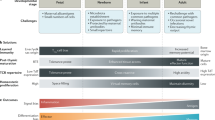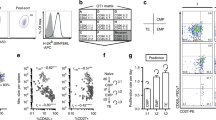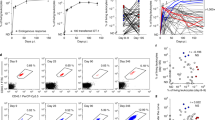Abstract
T cells are stimulated by stochastic exposure to antigen-presenting cells and cytokines. We review evidence that the level of signal that is accumulated determines progression through hierarchical thresholds for proliferation and differentiation, leading to the generation of various intermediates and effector T cells. These cells are then selected to enter the memory pool according to their fitness — that is, their capacity to access and use survival signals. We suggest that the intermediates that are generated by antigenic stimulation of T and B cells persist as central memory cells, which can mount secondary responses to antigen and maintain appropriate levels of effector cells and antibodies throughout the lifetime of an individual.
This is a preview of subscription content, access via your institution
Access options
Subscribe to this journal
Receive 12 print issues and online access
$209.00 per year
only $17.42 per issue
Buy this article
- Purchase on Springer Link
- Instant access to full article PDF
Prices may be subject to local taxes which are calculated during checkout


Similar content being viewed by others
References
Lanzavecchia, A. & Sallusto, F. Dynamics of T-lymphocyte responses: intermediates, effectors and memory cells. Science 290, 92–97 (2000).
Valitutti, S., Muller, S., Cella, M., Padovan, E. & Lanzavecchia, A. Serial triggering of many T-cell receptors by a few peptide–MHC complexes. Nature 375, 148–151 (1995).
Viola, A., Schroeder, S., Sakakibara, Y. & Lanzavecchia, A. T-lymphocyte costimulation mediated by reorganization of membrane microdomains. Science 283, 680–682 (1999).
Porgador, A., Yewdell, J. W., Deng, Y., Bennink, J. R. & Germain, R. N. Localization, quantitation and in situ detection of specific peptide–MHC class I complexes using a monoclonal antibody. Immunity 6, 715–726 (1997).
Dustin, M. L., Allen, P. M. & Shaw, A. S. Environmental control of immunological synapse formation and duration. Trends Immunol. 22, 192–194 (2001).
Stoll, S., Delon, J., Brotz, T. M. & Germain, R. N. Dynamic imaging of T-cell–dendritic cell interactions in lymph nodes. Science 296, 1873–1876 (2002).
Iezzi, G., Karjalainen, K. & Lanzavecchia, A. The duration of antigenic stimulation determines the fate of naive and effector T cells. Immunity 8, 89–95 (1998).
Crabtree, G. R. Contingent genetic regulatory events in T-lymphocyte activation. Science 243, 355–361 (1989).
Marrack, P. et al. Homeostasis of αβ TCR+ T cells. Nature Immunol. 1, 107–112 (2000).
Kunkel, E. J. & Butcher, E. C. Chemokines and the tissue-specific migration of lymphocytes. Immunity 16, 1–4 (2002).
Lenardo, M. et al. Mature T-lymphocyte apoptosis — immune regulation in a dynamic and unpredictable antigenic environment. Annu. Rev. Immunol. 17, 221–253 (1999).
Bird, J. J. et al. Helper T-cell differentiation is controlled by the cell cycle. Immunity 9, 229–237 (1998).
Langenkamp, A., Messi, M., Lanzavecchia, A. & Sallusto, F. Kinetics of dendritic-cell activation: impact on priming of TH1, TH2 and nonpolarized T cells. Nature Immunol. 1, 311–316 (2000).
Iezzi, G., Scheidegger, D. & Lanzavecchia, A. Migration and function of antigen-primed nonpolarized T lymphocytes in vivo. J. Exp. Med. 193, 987–993 (2001).
Langenkamp, A. et al. T-cell priming by dendritic cells: thresholds for proliferation, differentiation and death and intraclonal functional diversification. Eur. J. Immunol. 32, 2046–2054 (2002).
Zheng, W. & Flavell, R. A. The transcription factor GATA-3 is necessary and sufficient for TH2 cytokine gene expression in CD4 T cells. Cell 89, 587–596 (1997).
Szabo, S. J. et al. A novel transcription factor, T-bet, directs TH1-lineage commitment. Cell 100, 655–669 (2000).
Iezzi, G., Scotet, E., Scheidegger, D. & Lanzavecchia, A. The interplay between the duration of TCR and cytokine signalling determines T-cell polarization. Eur. J. Immunol. 29, 4092–4101 (1999).
Richter, A., Lohning, M. & Radbruch, A. Instruction for cytokine expression in T helper lymphocytes in relation to proliferation and cell-cycle progression. J. Exp. Med. 190, 1439–1450 (1999).
Szabo, S. J. et al. Distinct effects of T-bet in TH1-lineage commitment and IFN-γ production in CD4 and CD8 T cells. Science 295, 338–342 (2002).
Manjunath, N. et al. Effector differentiation is not prerequisite for generation of memory cytotoxic T lymphocytes. J. Clin. Invest. 108, 871–878 (2001).
Tzachanis, D. et al. Tob is a negative regulator of activation that is expressed in anergic and quiescent T cells. Nature Immunol. 2, 1174–1182 (2001).
Chen, W., Jin, W. & Wahl, S. M. Engagement of cytotoxic T-lymphocyte-associated antigen 4 (CTLA-4) induces transforming growth factor-β (TGF-β) production by murine CD4+ T cells. J. Exp. Med. 188, 1849–1857 (1998).
Mercado, R. et al. Early programming of T-cell populations responding to bacterial infection. J. Immunol. 165, 6833–6839 (2000).
Kaech, S. M. & Ahmed, R. Memory CD8+ T-cell differentiation: initial antigen encounter triggers a developmental program in naive cells. Nature Immunol. 2, 415–422 (2001).
van Stipdonk, M. J., Lemmens, E. E. & Schoenberger, S. P. Naive CTLs require a single brief period of antigenic stimulation for clonal expansion and differentiation. Nature Immunol. 2, 423–429 (2001).
Bevan, M. J. & Fink, P. J. The CD8 response on autopilot. Nature Immunol. 2, 381–382 (2001).
Lauvau, G. et al. Priming of memory but not effector CD8 T cells by a killed bacterial vaccine. Science 294, 1735–1739 (2001).
Masopust, D., Vezys, V., Marzo, A. L. & Lefrancois, L. Preferential localization of effector memory cells in nonlymphoid tissue. Science 291, 2413–2417 (2001).
Reinhardt, R. L., Khoruts, A., Merica, R., Zell, T. & Jenkins, M. K. Visualizing the generation of memory CD4 T cells in the whole body. Nature 410, 101–105 (2001).
Wang, X. & Mosmann, T. In vivo priming of CD4 T cells that produce interleukin (IL)-2 but not IL-4 or interferon (IFN)-γ, and can subsequently differentiate into IL-4- or IFN-γ-secreting cells. J. Exp. Med. 194, 1069–1080 (2001).
Roman, E. et al. CD4 effector T-cell subsets in the response to influenza: heterogeneity, migration and function. J. Exp. Med. 196, 957–968 (2002).
Hernandez, J., Aung, S., Marquardt, K. & Sherman, L. A. Uncoupling of proliferative potential and gain of effector function by CD8+ T cells responding to self-antigens. J. Exp. Med. 196, 323–333 (2002).
Badovinac, V. P., Porter, B. B. & Harty, J. T. Programmed contraction of CD8+ T cells after infection. Nature Immunol. 3, 619–626 (2002).
Plas, D. R., Rathmell, J. C. & Thompson, C. B. Homeostatic control of lymphocyte survival: potential origins and implications. Nature Immunol. 3, 515–521 (2002).
Sprent, J. & Surh, C. D. Generation and maintenance of memory T cells. Curr. Opin. Immunol. 13, 248–254 (2001).
Grayson, J. M., Zajac, A. J., Altman, J. D. & Ahmed, R. Cutting edge: increased expression of Bcl-2 in antigen-specific memory CD8+ T cells. J. Immunol. 164, 3950–3954 (2000).
Boise, L. H. et al. CD28 costimulation can promote T-cell survival by enhancing the expression of Bcl-XL . Immunity 3, 87–98 (1995).
Heath, W. R. & Carbone, F. R. Cross-presentation, dendritic cells, tolerance and immunity. Annu. Rev. Immunol. 19, 47–64 (2001).
Scheinecker, C., McHugh, R., Shevach, E. M. & Germain, R. N. Constitutive presentation of a natural tissue autoantigen exclusively by dendritic cells in the draining lymph node. J. Exp. Med. 196, 1079–1090 (2002).
Liu, K. et al. Immune tolerance after delivery of dying cells to dendritic cells in situ. J. Exp. Med. 196, 1091–1097 (2002).
Shevach, E. M. CD4+CD25+ suppressor T cells: more questions than answers. Nature Rev. Immunol. 2, 389–400 (2002).
Zheng, L. et al. Induction of apoptosis in mature T cells by tumour-necrosis factor. Nature 377, 348–351 (1995).
Moskophidis, D., Lechner, F., Pircher, H. & Zinkernagel, R. M. Virus persistence in acutely infected immunocompetent mice by exhaustion of antiviral cytotoxic effector T cells. Nature 362, 758–761 (1993).
Kaech, S. M., Wherry, E. J. & Ahmed, R. Effector and memory T-cell differentiation: implications for vaccine development. Nature Rev. Immunol. 2, 251–262 (2002).
Sallusto, F., Lenig, D., Forster, R., Lipp, M. & Lanzavecchia, A. Two subsets of memory T lymphocytes with distinct homing potentials and effector functions. Nature 401, 708–712 (1999).
Goldrath, A. W. et al. Cytokine requirements for acute and basal homeostatic proliferation of naive and memory CD8+ T cells. J. Exp. Med. 195, 1515–1522 (2002).
Tan, J. T. et al. Interleukin (IL)-15 and IL-7 jointly regulate homeostatic proliferation of memory phenotype CD8+ cells but are not required for memory phenotype CD4+ cells. J. Exp. Med. 195, 1523–1532 (2002).
Kieper, W. C. et al. Overexpression of interleukin (IL)-7 leads to IL-15-independent generation of memory phenotype CD8+ T cells. J. Exp. Med. 195, 1533–1539 (2002).
Becker, T. C. et al. Interleukin-15 is required for proliferative renewal of virus-specific memory CD8 T cells. J. Exp. Med. 195, 1541–1548 (2002).
Breitfeld, D. et al. Follicular B-helper T cells express CXC-chemokine receptor 5, localize to B-cell follicles, and support immunoglobulin production. J. Exp. Med. 192, 1545–1552 (2000).
Schaerli, P. et al. CXC-chemokine receptor 5 expression defines follicular homing T cells with B-cell helper function. J. Exp. Med. 192, 1553–1562 (2000).
Messi, M. et al. Memory and flexibility of cytokine gene expression as separable properties of human TH1 and TH2 lymphocytes. Nature Immunol. (in the press) (2002).
Champagne, P. et al. Skewed maturation of memory HIV-specific CD8 T lymphocytes. Nature 410, 106–111 (2001).
Unsoeld, H., Krautwald, S., Voehringer, D., Kunzendorf, U. & Pircher, H. Cutting edge: CCR7+ and CCR7− memory T cells do not differ in immediate effector-cell function. J. Immunol. 169, 638–641 (2002).
Ahmed, R. & Gray, D. Immunological memory and protective immunity: understanding their relation. Science 272, 54–60 (1996).
Harris, N. L., Watt, V., Ronchese, F. & Le Gros, G. Differential T-cell function and fate in lymph node and nonlymphoid tissues. J. Exp. Med. 195, 317–326 (2002).
Geginat, J., Sallusto, F. & Lanzavecchia, A. Cytokine-driven proliferation and differentiation of human naive, central memory, and effector memory CD4+ T cells. J. Exp. Med. 194, 1711–1719 (2001).
Wu, C. Y. et al. Distinct lineages of TH1 cells have differential capacities for memory cell generation in vivo. Nature Immunol. 3, 852–858 (2002).
Doyle, A. G., Buttigieg, K., Groves, P., Johnson, B. J. & Kelso, A. The activated type 1-polarized CD8+ T-cell population isolated from an effector site contains cells with flexible cytokine profiles. J. Exp. Med. 190, 1081–1092 (1999).
Liu, Y. J. & Banchereau, J. Regulation of B-cell commitment to plasma cells or to memory B cells. Semin. Immunol. 9, 235–240 (1997).
Calame, K. L. Plasma cells: finding new light at the end of B-cell development. Nature Immunol. 2, 1103–1108 (2001).
Fearon, D. T., Manders, P. & Wagner, S. D. Arrested differentiation, the self-renewing memory lymphocyte and vaccination. Science 293, 248–250 (2001).
Kuo, C. T., Veselits, M. L. & Leiden, J. M. LKLF: a transcriptional regulator of single-positive T-cell quiescence and survival. Science 277, 1986–1990 (1997).
Mittrucker, H. W. et al. Requirement for the transcription factor LSIRF/IRF4 for mature B- and T-lymphocyte function. Science 275, 540–543 (1997).
Manz, R. A., Thiel, A. & Radbruch, A. Lifetime of plasma cells in the bone marrow. Nature 388, 133–134 (1997).
Slifka, M. K., Antia, R., Whitmire, J. K. & Ahmed, R. Humoral immunity due to long-lived plasma cells. Immunity 8, 363 –372(1998).
Bernasconi, N. L., Traggiai, E. & Lanzavecchia, A. Maintenance of serological memory by polyclonal activation of human memory B cells. Science (in the press) (2002).
Acknowledgements
We thank Klaus Karjalainen for critical reading of this manuscript and suggestions. A. L. is supported by the Helmut Horten Foundation and by a grant from the Swiss National Science Foundation. F.S. is supported by a grant from The European Community.
Author information
Authors and Affiliations
Corresponding authors
Glossary
- CENTRAL-MEMORY CELLS
-
Memory T and B cells that home to secondary lymphoid organs. These cells are heterogeneous and do not have the full range of functions that are characteristic of effector T cells or plasma cells. They are responsible for secondary or chronic responses to antigen and might be involved in long-term maintenance of effector-memory cells.
- CROSS-PRESENTATION
-
The presentation of exogenous antigen by MHC class I molecules.
- DIFFERENTIATION
-
Refers to changes in the expression of genes that control the cell cycle, fitness, homing, effector function and survival. These transcriptional programmes can be regulated coordinately — for example, homing and effector function.
- EFFECTOR-MEMORY CELLS
-
Memory T cells that home to peripheral tissues and plasma cells that home to the bone marrow and secrete antibodies. They are responsible for immediate protection against antigen challenge.
- EPIGENETIC
-
Refers to the heritable, but potentially reversible, states of gene activity that are imposed by the structure of chromatin or covalent modifications of DNA and histones.
- INTERMEDIATES
-
Clonally expanded T cells that have been arrested at an intermediate stage of differentiation. Depending on the strength of signal that is received, these cells express different levels of fitness, effector function and migratory capacity.
- SIGNAL STRENGTH
-
Refers to the overall amount of signal transduced through the T-cell receptor. This is determined by the concentration of antigen, extent of signal amplification by co-stimulatory molecules and duration of the antigen-presenting-cell–T-cell interaction. These parameters can vary widely and in a stochastic fashion.
Rights and permissions
About this article
Cite this article
Lanzavecchia, A., Sallusto, F. Progressive differentiation and selection of the fittest in the immune response. Nat Rev Immunol 2, 982–987 (2002). https://doi.org/10.1038/nri959
Issue Date:
DOI: https://doi.org/10.1038/nri959
This article is cited by
-
Vaccination in patients with kidney failure: lessons from COVID-19
Nature Reviews Nephrology (2022)
-
Bone marrow central memory and memory stem T-cell exhaustion in AML patients relapsing after HSCT
Nature Communications (2019)
-
T memory stem cells in health and disease
Nature Medicine (2017)
-
Fate and Plasticity of the Epidermis in Response to Congenital Activation of BRAF
Journal of Investigative Dermatology (2015)
-
Essential role for autophagy in the maintenance of immunological memory against influenza infection
Nature Medicine (2014)



